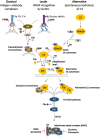Complement in malaria: immune evasion strategies and role in protective immunity
- PMID: 32181490
- PMCID: PMC8653895
- DOI: 10.1002/1873-3468.13772
Complement in malaria: immune evasion strategies and role in protective immunity
Abstract
The malaria parasite has for long been thought to escape host complement attack as a survival strategy. However, it was only recently that complement evasion mechanisms of the parasite were described. Simultaneously, the role of complement in antibody-mediated naturally acquired and vaccine-induced protection against malaria has also been reported. Such findings should be considered in future vaccine design, given the current need to develop more efficacious vaccines against malaria. Parasite antigens derived from molecules mediating functions crucial for parasite survival, such as complement evasion, or parasite antigens against which antibody responses lead to an efficient complement attack could present new candidates for vaccines. In this review, we discuss recent findings on complement evasion by the malaria parasites and the emerging role of complement in antibody-mediated protection against malaria. We emphasize that immune responses to vaccines based on complement inhibitors should not only induce complement-activating antibodies but also neutralize the escape mechanisms of the parasite.
Keywords: Plasmodium; complement; immunity; malaria.
© 2020 The Authors. FEBS Letters published by John Wiley & Sons Ltd on behalf of Federation of European Biochemical Societies.
Figures






Similar articles
-
Beyond Binding: The Outcomes of Antibody-Dependent Complement Activation in Human Malaria.Front Immunol. 2021 Jun 8;12:683404. doi: 10.3389/fimmu.2021.683404. eCollection 2021. Front Immunol. 2021. PMID: 34168652 Free PMC article. Review.
-
Complement in malaria immunity and vaccines.Immunol Rev. 2020 Jan;293(1):38-56. doi: 10.1111/imr.12802. Epub 2019 Sep 26. Immunol Rev. 2020. PMID: 31556468 Free PMC article. Review.
-
Deposition of complement regulators on the surface of Plasmodium falciparum merozoites depends on the immune status of the host.PLoS Pathog. 2025 Apr 28;21(4):e1013107. doi: 10.1371/journal.ppat.1013107. eCollection 2025 Apr. PLoS Pathog. 2025. PMID: 40294075 Free PMC article.
-
Antibody effector functions in malaria and other parasitic diseases: a few needles and many haystacks.Immunol Cell Biol. 2020 Apr;98(4):264-275. doi: 10.1111/imcb.12320. Epub 2020 Feb 24. Immunol Cell Biol. 2020. PMID: 32003072 Review.
-
Plasmodium falciparum Gametes and Sporozoites Hijack Plasmin and Factor H To Evade Host Complement Killing.Microbiol Spectr. 2023 Jun 15;11(3):e0449322. doi: 10.1128/spectrum.04493-22. Epub 2023 May 16. Microbiol Spectr. 2023. PMID: 37191558 Free PMC article.
Cited by
-
Plasmodium berghei HMGB1 controls the host immune responses and splenic clearance by regulating the expression of pir genes.J Biol Chem. 2024 Nov;300(11):107829. doi: 10.1016/j.jbc.2024.107829. Epub 2024 Sep 27. J Biol Chem. 2024. PMID: 39341498 Free PMC article.
-
Host-parasite interactions during Plasmodium infection: Implications for immunotherapies.Front Immunol. 2023 Jan 4;13:1091961. doi: 10.3389/fimmu.2022.1091961. eCollection 2022. Front Immunol. 2023. PMID: 36685595 Free PMC article. Review.
-
The Defensive Interactions of Prominent Infectious Protozoan Parasites: The Host's Complement System.Biomolecules. 2022 Oct 26;12(11):1564. doi: 10.3390/biom12111564. Biomolecules. 2022. PMID: 36358913 Free PMC article. Review.
-
Different PfEMP1-expressing Plasmodium falciparum variants induce divergent endothelial transcriptional responses during co-culture.PLoS One. 2023 Nov 30;18(11):e0295053. doi: 10.1371/journal.pone.0295053. eCollection 2023. PLoS One. 2023. PMID: 38033133 Free PMC article.
-
Pathogenetic mechanisms and treatment targets in cerebral malaria.Nat Rev Neurol. 2023 Nov;19(11):688-709. doi: 10.1038/s41582-023-00881-4. Epub 2023 Oct 19. Nat Rev Neurol. 2023. PMID: 37857843 Review.
References
-
- WHO (2019) WHO | World malaria report 2019. WHO.
-
- White NJ, Pukrittayakamee S, Hien TT, Faiz MA, Mokuolu OA, Dondorp AM and White NJ (2014) Malaria. Lancet 383, 723–735. - PubMed
-
- Rosenberg R, Burge R and Schneider I (1990) An estimation of the number of malaria sporozoites ejected by a feeding mosquito. Trans R Soc Trop Med Hyg 84, 209–212. - PubMed
Publication types
MeSH terms
Substances
Grants and funding
LinkOut - more resources
Full Text Sources
Medical

